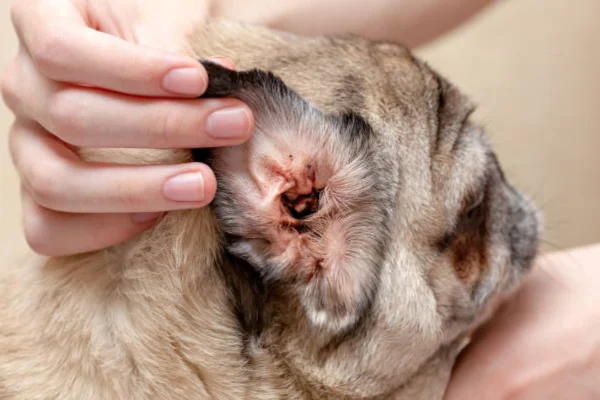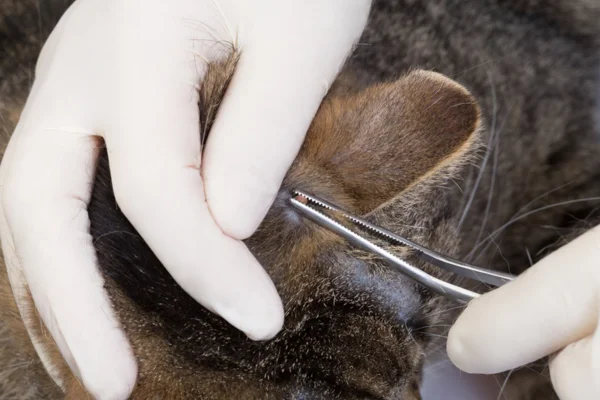Mites in Dogs
Symptoms, Treatments and Prevention for a Healthy Pet
Mites in Dogs - When it comes to caring for our canine friends, ensuring that they are free of parasites is fundamental to their health and well-being. Among the many parasites that can bother our pets, mites are some of the most common and problematic. These microorganisms, invisible to the naked eye, can cause a range of problems, from mild itching to serious skin infections. In this article, we'll explore in detail what mites are, how they affect dogs, the symptoms that indicate their presence, the treatments available and, most importantly, how to prevent these parasites from causing problems for your dog.
What Are Mites and How Do They Affect Dogs?
Mites are small arachnids belonging to the same class as spiders and ticks. Although there are thousands of species of mites, only a few are known to cause problems in dogs. These parasites live on dogs' skin, where they feed on dead cells, oils and even blood, depending on the species. The presence of mites can lead to various skin conditions, known as mange or dermatitis, depending on the type of mite involved.
Common Types of Mites in Dogs
There are several types of mites that can affect dogs, each of which causes different types of skin infections. Let's explore the most common ones:
Contents
- Sarcoptes scabieiThis mite is responsible for sarcoptic mange, one of the most common and contagious forms of mange. It penetrates the dog's skin, causing intense itching, redness and hair loss. It is highly contagious and can be transmitted to other animals and even humans.
- Demodex canisKnown for causing demodectic mange, this mite lives naturally in the hair follicles and sebaceous glands of dogs' skin. Under normal conditions, it doesn't cause any problems, but when the dog's immune system is compromised, these mites can multiply uncontrollably, resulting in skin infections, hair loss and inflammation.
- Otodectes cynotisThese mites, known as ear mites, cause otitis externa, an infection of the external ear canal. They are especially common in puppies and can cause intense itching in the ears, head shaking and excessive earwax.
- Cheyletiella spp.Known as "walking dandruff", these mites live on the surface of the skin and feed on keratin and body fluids. They are visible to the naked eye as small white dots and cause itching and flaking of the skin.

Symptoms of Mite Infestations
The symptoms of a mite infestation in dogs vary depending on the type of mite, but some common signs can indicate the presence of these parasites. Pet owners should pay attention to the following symptoms:
- Excessive itchingOne of the most common signs is intense itching, which can lead to the dog scratching, biting or licking its skin constantly.
- Skin Redness and IrritationThe dog's skin can become red and inflamed, especially in the areas most affected by mites, such as the belly, ears, paws and around the eyes.
- Hair loss: Hair loss is common, especially in areas where itching is more intense. In cases of demodectic mange, there may be hair loss in specific areas, such as around the eyes, muzzle and paws.
- Wounds and scabsConstant itching can lead to open sores which, over time, can turn into scabs, increasing the risk of secondary infections.
- Behavioral changesA dog infested with mites may become more irritable or withdrawn due to the constant discomfort caused by itching and pain.
- Excessive Wax or Unpleasant Odor in the EarsIn the case of ear mites, it is common to notice an excess of dark or yellowish wax, as well as a strong, unpleasant smell coming from the dog's ears.
Diagnosis: How Do You Know If Your Dog Has Mites?
If you suspect that your dog is infested with mites, it is essential to take him to the vet for a proper diagnosis. The vet will carry out a detailed physical examination and may use some specific techniques to confirm the presence of mites:
- Skin scrapingThis is the most common technique for diagnosing mites. The vet will scrape a small area of the dog's skin to take samples, which will be examined under a microscope.
- Earwax examinationFor ear mites, the vet can take wax samples from the ears and examine them under a microscope to identify the presence of mites.
- Blood TestsIn some cases, especially when the infestation is associated with immune problems, the vet may order blood tests to assess the dog's general health.
Available Treatments for Mite Infestations
Treatment for mite infestations in dogs can vary depending on the type of mite involved, the severity of the infestation and the dog's general state of health. However, there are common approaches that are effective in most cases:
- Topical medicationsMedicinal creams, ointments and lotions can be applied directly to the affected areas to kill the mites and relieve skin irritation. Topical medications containing ingredients such as permethrin, selamectin and moxidectin are often prescribed.
- Medicinal bathsBathing with specific scabies shampoos, which contain mild insecticides, can help eliminate the mites from the skin and reduce itching and irritation.
- Systemic medicationsIn more serious cases, the vet may prescribe oral or injectable medications that act internally to eliminate the mites. Ivermectin and milbemycin oxime are common examples of systemic medications used to treat mange.
- Regular ear cleaningFor ear mites, careful and regular cleaning of the ears with solutions recommended by the vet is essential to eliminate the mites and prevent re-infestation.
- AntibioticsIf the dog has developed secondary infections due to the sores caused by itching, the vet may prescribe antibiotics to treat these infections.
- Immune supportIn cases of demodectic mange, where the dog's immune system is compromised, it may be necessary to administer supplements or medications to help strengthen the animal's immune system.

Prevention: How to Protect Your Dog from Dust Mites
Preventing mite infestations is always better than treating them, and there are several measures you can take to protect your dog from these parasites:
- Maintaining Environmental HygieneOne of the best ways to prevent dust mites is to keep your dog's living environment clean and sanitized. Regularly vacuum carpets, beds and areas where your dog spends the most time. Wash the dog's bed and toys frequently.
- Avoid Contact with Infested AnimalsSarcoptic mange, in particular, is highly contagious, so avoid letting your dog come into contact with animals that may be infested.
- Regular visits to the vetRegular visits to the vet can help detect skin problems early, before the mite infestation becomes serious.
- Nutritional supplementationA strong immune system is crucial for preventing infestations. A balanced diet and, if necessary, supplements recommended by the vet, can help keep your dog's immune system in good condition.
- Preventive ProductsThere are preventative products on the market, such as pipettes and collars, which contain ingredients that keep mites, fleas and ticks away. Consult your vet for
know which products are best for your dog and how to use them safely.
Final considerations
Dust mites may be small, but the problems they cause can be huge if they are not treated properly. Maintaining a clean environment, paying attention to signs of discomfort in your dog and seeking immediate veterinary treatment are essential steps to ensure that your furry friend is always healthy and happy.
Preventing mite infestations not only protects your dog, but also contributes to the well-being of the whole family by preventing parasites from spreading to other animals or even humans. By adopting a preventative approach and treating any signs of infestation quickly, you'll be doing the best thing for your dog, giving him a long, healthy and discomfort-free life.
Remember, your dog's health is in your hands. With knowledge, prevention and proper care, you can ensure that mites are just a distant concern and not a real problem in your home. If you notice any suspicious symptoms or have any doubts about your pet's health, don't hesitate to go to a trusted veterinarian. After all, our dogs trust us to look after them, and we must do our best to ensure that they live their lives in comfort and joy.








